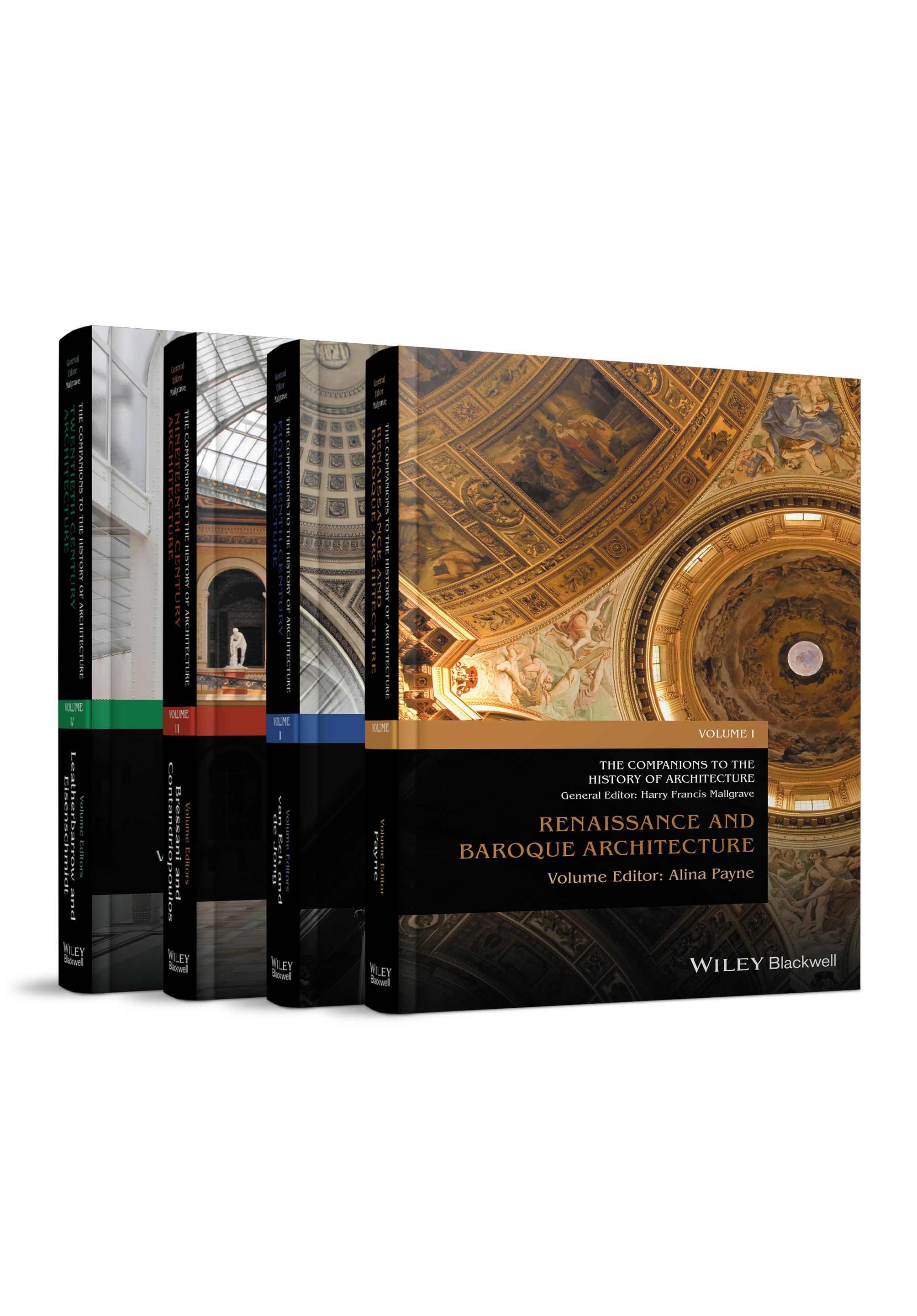Companion to the History of Architecture
Editors & Contributors
General Editor
Harry Francis Mallgrave has enjoyed a distinguished career
as an award-winning scholar, translator, and editor, and is
presently Professor of Architectural History and Theory at Illinois
Institute of Technology. He has authored more than a dozen books,
including Empathy, Form & Space (1994), Gottfried
Semper: Architect of the Nineteenth Century (1996), Modern
Architectural Theory: A Historical Survey 1673–1968 (2005), and
Architecture and Embodiment: The Implications of the New
Sciences and Humanities for Design (2013).
Volume I, Renaissance and Baroque Architecture
Edited by Alina Payne, Alexander P. Misheff Professor of History of
Art and Architecture, Harvard University, USA
Alina Payne is the author of The Architectural Treatise in the Italian Renaissance (1999; Hitchcock Prize), Rudolf Wittkower (2010), From Ornament to Object. Genealogies of Architectural Modernism (2012), and The Telescope and the Compass. Teofilo Gallaccini and the Dialogue between Architecture and Science in the Age of Galileo (2012); and editor of Dalmatia and the Mediterranean. Portable Archaeology and the Poetics of Influence (2013) and Vision and Its Instruments. Art, Science and Technology in Early Modern Europe (2014), and co-editor of Antiquity and Interpreters (2000). In 2006 she received the Max Planck and Alexander von Humboldt Prize in the Humanities.
Volume II, Eighteenth-Century Architecture
Edited by Caroline van Eck and Sigrid de Jong
Caroline van Eck is is Professor of Early Modern Art and Architecture at Leiden University, the Netherlands. She received a doctorate in aesthetics from the University of Amsterdam, and has taught at Amsterdam, Ghent, Yale and York. In 2017 she will give the Slade Lectures at Oxford. Recent publications include Classical Rhetoric and the Arts in Early Modern Europe (Cambridge 2007), Translations of the Sublime (with Stijn Bussels; Leiden and Boston 2012) and Art, Agency and Living Presence. From the Animated Image to the Excessive Object (Berlin and Leiden 2015).
Sigrid de Jong is a postdoctoral researcher and lecturer at Leiden University, the Netherlands. She obtained her doctorate in art and architectural history at Leiden University. She currently conducts a research project on ‘Experience and Design: The Emergence of Architectural Experience in Paris and London, 1750-1815’ funded by the Netherlands Organisation for Scientific Research (NWO). Her previous postdoctoral research project was on primitivism and architectural theory in the NWO-funded project ‘The Quest for the Legitimacy of Architecture 1750-1850’, led by Maarten Delbeke. Her book, based on her Ph.D. thesis, Rediscovering Architecture: Paestum in Eighteenth-Century Architectural Experience and Theory, was published by Yale University Press in 2014.
Volume III, Nineteenth-Century Architecture
Edited by Martin Bressani and Christina Contandriopoulos
Martin Bressani is director of McGill University’s School of Architecture in Montréal. He has contributed essays on nineteenth-century European architecture in many books and scholarly journals. He is the author of a monograph on French neo-Gothic architect and theoretician Eugène-Emmanuel Viollet-le-Duc titled Architecture and the Historical Imagination: Eugène-Emmanuel Viollet-le-Duc (2014).
Christina Contandriopoulos is Professor of architectural
history in the Department of Art History at the Université du
Québec à Montreal (UQAM). She received her professional degree at
the Université de Montréal and was awarded a post-professional
Masters and a Ph.D. from McGill University. Her research and
publications focus on architectural representation as well as on
the intersections between geology, archeology and architecture in
the nineteenth century. She is co-editor of the anthology
Architectural Theory 1871-2005, (with Harry Mallgrave,
Blackwell-Wiley, 2008) and guest editor of a special issue of the
Journal of Architectural Education on Utopia in contemporary
architecture (Taylor and Francis, March 2013).
Volume IV, Twentieth-Century Architecture
Edited by David Leatherbarrow and Alexander Eisenschmidt
David Leatherbarrow is Professor of Architecture the
University of Pennsylvania, where he also serves as Chairman of the
Graduate Group in Architecture (Ph.D. Program). He teaches
architectural design, as well as the history and theory of
architecture, gardens, and cities. He lectures widely, throughout
the world, and holds guest professorships in Denmark and China. His
recent books include: Architecture Oriented Otherwise;
Topographical Stories: studies in landscape and architecture;
Surface Architecture, in collaboration with Mohsen
Mostafavi; and Uncommon Ground: architecture, technology and
topography. Before that were: On Weathering: the life of
buildings in time, again with Mostafavi, and The Roots of
Architectural Invention: site, enclosure and materials.
Alexander Eisenschmidt is a designer and theorist, currently based in Chicago, where he teaches as an Assistant Professor of Architecture at the University of Illinois at Chicago. His work engages the productive tension between the modern city and architectural form – a topic on which he has lectured, chaired conferences, and published extensively. He is the editor of City Catalyst (Architectural Design, 2012), the lead-editor of Chicagoisms (Scheidegger & Spiess, 2013), and from 2012 to 2013 was the reviews editor of the Journal of Architectural Education. Eisenschmidt is the curator and designer of “Collective City” for the 2015 International Biennale on Urbanism in Shenzhen, China, the co-curator of “Chicagoisms” at the Art Institute of Chicago in 2014, and the curator of City Works at the 13th International Venice Biennale in Architecture in 2012 to which he also contributed a 100 ft. long panorama drawing. His current book project is entitled The Good Metropolis.



